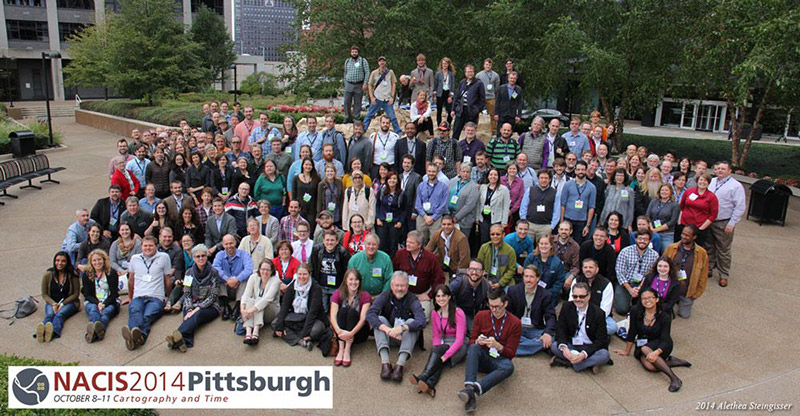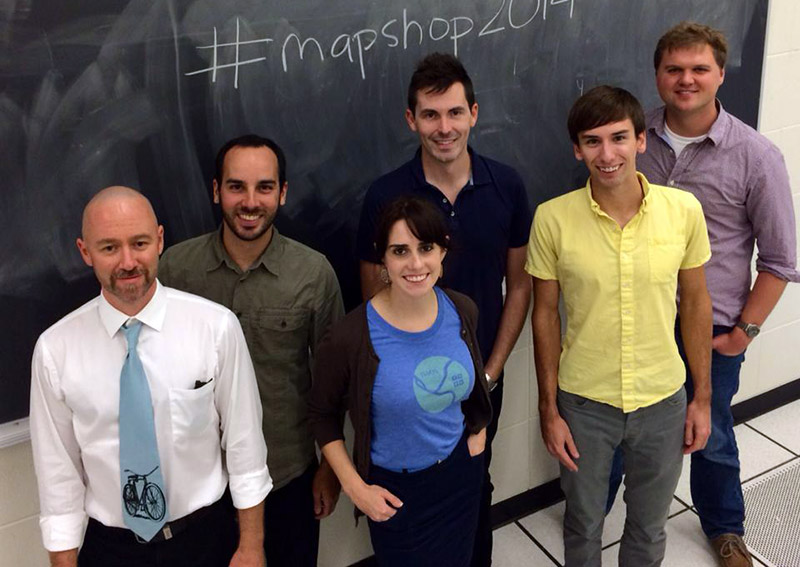On practical cartography
Another carto-year has come to a close. A carto-year is measured from October to October, or more specifically, between NACIS conferences. If you’re not a NACIS regular, come to a few meetings and you’ll understand. It’s the New Year’s Eve of cartography—an intellectual, visual, and social celebration of mapping that at once exhausts you and leaves you excited for things to come.
 Maptober road trip. “Map selfie” by Mike Foster.
Maptober road trip. “Map selfie” by Mike Foster.
It seems that the theme of my carto-year was practical cartography: those everyday details of working with data, using software, writing code, and so on. The how of cartography.
For a second year I co-organized Practical Cartography Day at NACIS (this time with Rosemary Wardley of National Geographic), a pre-conference day of presentations focused on tips and tricks of everyday mapping, as opposed to less hands-on topics like theory, map use, or even design. We had twenty presentations, from bite-sized tips to software demos to behind-the-scenes looks at how some cool maps were made. PCD drew a crowd of 150, about half the size of the main conference. Most of the talks have slides or other material online, so check out the links in the schedule: parts 1, 2, 3, and 4.
 NACIS group photo by Alethea Steingisser. Scores of smiles, plus Matt Wilson looking at his phone. #notmattwilson
NACIS group photo by Alethea Steingisser. Scores of smiles, plus Matt Wilson looking at his phone. #notmattwilson
Back home, a few of us jumped on the Maptime train and established a Boston chapter. Jake Wasserman, Mike Foster, and I shared the goals and frustrations that gave rise to the original Maptime: there’s a ton happening in mapping right now, and it’s hard for newcomers to find a friendly and supportive learning environment. We’ve held five Maptime Boston meetups so far, mostly focused on tutorial exercises. It’s been so nice to see people learn something new, then come back and share a map they’ve made with those new skills. Meanwhile, veteran mappers also show up and happily share their know-how. See some Maptime Boston stuff on GitHub, and if you’re anywhere near here, be sure to join the Meetup group.
 Maptime Boston, or for Ryan and me, Snacktime Boston.
Maptime Boston, or for Ryan and me, Snacktime Boston.
Another event was a short “mapshop” at the University of Kentucky immediately following NACIS, hosted by Matt Wilson and Rich Donohue. This involved Rich and four of us guests (John Czaplewski, Mike Foster, Carolyn Fish, and I) sharing perspectives on different aspects of “new maps,” which mostly meant showing some demos of various tasks and tools. That’s in spite of a critical bent at UK Geography—I was described as the “capitalist” among the guests, which I guess means the only one who has a normal job outside a state university.
 Rich, me, Carolyn, Matt, John, and Mike, temporarily not on a bourbon distillery tour.
Rich, me, Carolyn, Matt, John, and Mike, temporarily not on a bourbon distillery tour.
That’s all to say that I’ve been increasingly interested in “how?” as the primary question of cartography, at least in a learning process. This may be in contrast to some things I’ve rambled about in the past. I still believe in thoughtful mapmaking and asking questions beyond the technical, but most of those questions are secondary—not in the sense of being less important, but simply in the sense of coming later. Learn to make a map before learning to make a good map. If you don’t start with the how, you’re going to struggle.
The state of cartography is strong thanks mostly to those who ask “how?” before anything else. It’s interesting to revisit a Denis Wood rant against academic cartography from 2003, Cartography is Dead (Thank God!), taking it to mean that cartography—sorry, mapmaking—has always been about the doing. If Wood was to be believed a decade ago, it’s all even more true today, as web mapping grows explosively under the leadership of technical people who may scarcely be aware that any other level of cartography even exists.
On the other side, academic cartography still appears reluctant to embrace modern technical skill in education, saying something like “cartography isn’t about the tools” even though modern tools have thoroughly transformed the practice. I always attend cartographic education panels at conferences (NACIS and FOSS4G this year) and listen to educators discuss—to no avail, generally—their struggles with teaching concepts and not just button-pushing… or code. From the sound of it, the usual result is an awkward lecture/lab split in which students receive barely enough technical instruction to make a map, never mind actually realizing most of the concepts they learn in lecture.
I’m not close enough to academia these days to say much more about it. Suffice it to say that how is the hardest part of mapping, and is a vital part of cartographic education. It’s not enough to know what a good map is; it’s necessary to know how to make it. A failure to grasp lecture material might keep one from being a stellar cartographer, but a failure to grasp lab material will keep one from being a cartographer at all. Don’t push aside technical skill for fear of neglecting theory and design concepts. Participation, not pedantry, is the means for formally educated cartographers to affect the current technology-driven cartographic progress. Make room in a curriculum to teach the technology right. When it’s done well, technical skills are extensible, not just an exercise in button-pushing.
Continue to ask “how?”. Learn the technical skills, or teach them if you are an educator. Don’t seek perfection in design until you actually know how to build it. But don’t ever be intimidated; remember that learning how to make even the simplest map, just a pushpin on your house, is an amazing accomplishment. From there, you can go anywhere.
Tagged maptime, nacis, practical cartography


2 Comments